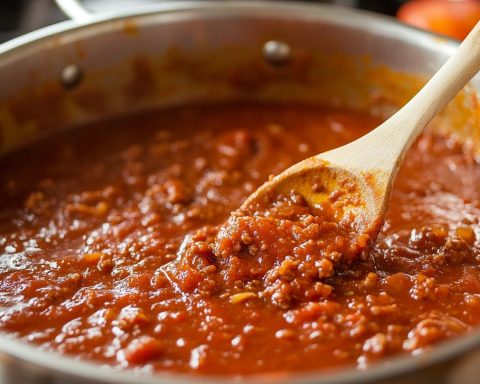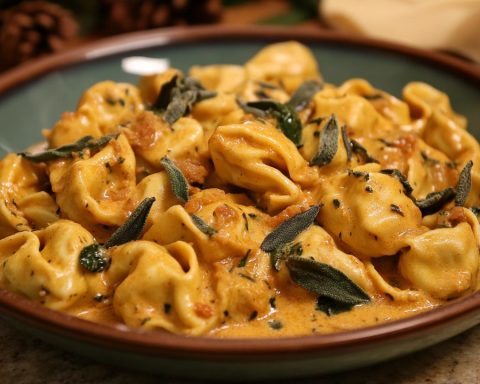In the quaint villages of Italy, where the rolling hills meet the golden sun, the classical minestrone has held its revered place on family tables for generations. Known affectionately as minestra, this robust soup is a celebration of the changing seasons—a culinary homage to the bountiful harvest of garden vegetables. As you ladle a steaming bowlful, inhale the scents of earthy produce, aromatic herbs, and just a hint of the salt-laden coastal breeze. Klassikaline Minestrone is not merely sustenance; it is a soulful journey to simpler times, perfect for kindling warmth on a chilly evening, or sharing laughter-filled lunches on a languid Sunday afternoon. Its melody of flavors dances between sweet, ripe tomatoes, the subtle bitterness of kale, and the fragrant embrace of fresh basil. Embrace this time-honored dish, savor its depth and richness with each nourishing spoonful.
Ingredients:
– 2 tablespoons of extra-virgin olive oil
– 1 medium yellow onion, finely chopped
– 2 cloves of garlic, minced
– 2 carrots, peeled and diced
– 2 celery stalks, diced
– 1 zucchini, diced
– 1 cup green beans, chopped into 1-inch pieces
– 2 medium potatoes, peeled and diced
– 1 can (14 oz) of diced tomatoes
– 1 tablespoon tomato paste
– 6 cups vegetable broth or water
– 1 can (15 oz) of cannellini beans, drained and rinsed
– 1 cup small pasta (such as ditalini)
– 1 teaspoon dried oregano
– 1 teaspoon dried thyme
– Salt and black pepper, to taste
– 2 cups chopped kale
– 1/4 cup fresh basil leaves
– Freshly grated Parmesan cheese, for serving
Instructions:
Step 1: Begin the Aromatic Base
In a large, heavy-bottomed pot, heat the extra-virgin olive oil over medium heat. Add the finely chopped onion and sauté until translucent, about 5 minutes. Stir in the minced garlic and cook for an additional minute, enjoying as the kitchen fills with its aromatic allure.
Step 2: Build the Flavor Layers
Add the diced carrots, celery, and a pinch of salt to the pot. Cook while stirring occasionally, for about 10 minutes, or until the vegetables have softened slightly. Next, introduce the zucchini, green beans, and potatoes, and continue to sauté, ensuring each vegetable becomes a part of this flavorful symphony.
Step 3: Simmer with Vibrancy
Stir in the diced tomatoes and tomato paste, mixing well to coat the vegetables with the rich, tangy essence. Pour in the vegetable broth or water and bring to a gentle boil. Reduce the heat to low, allowing the soup to simmer graciously for 20 minutes, granting the vegetables the time to tenderize and release their sweetness.
Step 4: The Heart and Soul
Add the drained cannellini beans and pasta to the pot, bringing the soup back to a gentle boil. Season with dried oregano, thyme, salt, and black pepper, adjusting to taste. Simmer for an additional 10-12 minutes, stirring occasionally, until the pasta is cooked al dente.
Step 5: Add Greenery and Finish
Stir in the chopped kale, welcoming the burst of green as it wilts into the broth. Allow it to meld for 2-3 minutes. Before serving, taste and adjust seasonings if necessary. Remove from heat and stir in the fresh basil leaves.
Serve with a Touch of Italy
Ladle the minestrone into bowls and top each with a generous sprinkle of freshly grated Parmesan cheese. Serve alongside rustic bread or a simple green salad for a true Italian feast.
Cooking Tips:
– For added depth, toss in a Parmesan rind during the simmering process—just remember to fish it out before serving.
– If you prefer a thicker soup, use a potato masher to gently crush some of the cooked vegetables and beans in the pot before adding the pasta.
Pairing Suggestions:
Complement this classic dish with a robust Italian red wine like Chianti or a crisp white such as Pinot Grigio. A simple dessert of panna cotta with berries can beautifully round off the meal, leaving your guests with a sweet, lasting impression of Italian warmth and hospitality. Enjoy your culinary adventure!
What You Didn’t Know About Minestrone Soup: Surprising Facts and Controversies
Minestrone, the iconic Italian soup, might seem like a straightforward dish, but its legacy and variations carry intriguing stories and occasional controversies. Let’s dig deeper into this beloved classic.
Surprising Facts
Did you know minestrone was originally a “poor man’s dish”? Its inception was rooted in poverty, where families used leftover pasta and whatever vegetables were at hand to create a filling meal. Over time, it became a celebrated staple, revered across different regions of Italy.
Contrary to popular belief, there isn’t one “traditional” minestrone recipe. Recipes vary dramatically by region and season, influenced by local produce availability. In Genova, for instance, pesto might be added for a unique twist, while in Venice, it’s common to include rice instead of pasta.
Controversies and Questions
A recurring debate among food aficionados is whether pasta or rice should accompany minestrone. In Tuscany, for example, rice is often preferred, a choice that sometimes stirs heated debates among culinary purists.
Moreover, is minestrone a summer or winter dish? Traditionally, it was made year-round with seasonal vegetables; however, today, variations abound that cater to every season, blurring these lines further.
Innovative Pairings
Have you ever paired minestrone with seafood? In coastal areas of Italy, mussels or calamari are sometimes added to infuse the soup with a maritime essence, blending land and sea in a harmonious dish.
For more culinary exploration or to delve into Italian gastronomic culture, visit Italy Food, where traditional and modern interpretations of Italian cuisine meet. Discover more than just recipes and experience the rich tapestry of Italian culinary heritage.
So, is minestrone on your menu tonight? If not yet, perhaps these lesser-known insights will spark your inspiration to revisit this classic with a new perspective. Buon appetito!








